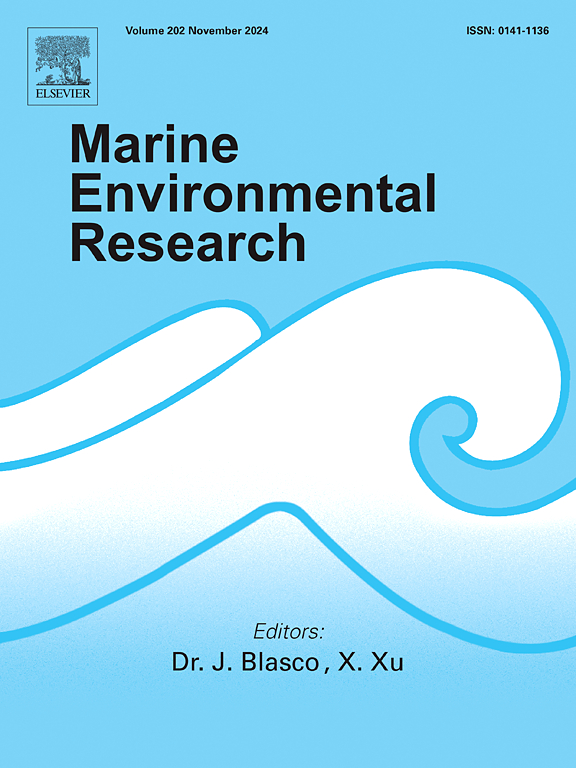Evaluating the toxicity of produced water from carbonate reservoirs in the North sea using oyster Embryo development tests
IF 3.2
3区 环境科学与生态学
Q2 ENVIRONMENTAL SCIENCES
引用次数: 0
Abstract
Produced water (PW) is the largest waste stream from offshore oil and gas production and a major contributor to marine pollution. In the North East Atlantic, approximately 287 million m3 of PW—containing hydrocarbons, suspended particulate matter (SPM), metals, and production chemicals—is discharged annually, including ∼18 million m3 from Danish operations. While current OSPAR regulations and risk-based approaches (RBA) rely on oil-in-water limits and acute tests PNECs, they often overlook chronic and sublethal effects, particularly from unregulated naturally occurring compounds. Early life stages of marine invertebrates, such as the Pacific oyster Magallana gigas, are highly sensitive to such contaminants and serve as effective bioindicators. This study applies the M. gigas embryo bioassay to PW samples from multiple Danish North Sea fields, using manipulations that remove SPM and purge volatile compounds to help identify toxicity drivers. The results showed that most of PW samples inhibited larval development, with significant differences among fields and sampling times, even in identically treated samples. PW from two out of four fields exhibited notably higher toxicity, potentially linked to elevated SPM content, metals, and production practices such as waterflooding. Evidence suggests that SPM may act as a carrier for pollutants, slightly increasing toxicity. Temporal variation in PW toxicity further indicates that more frequent monitoring is needed to capture fluctuations in discharge composition and associated risks. Given that carbonate reservoirs dominate global oil and gas production and M. gigas is established in the North Sea, these findings have both regional and global relevance. They underscore the importance of integrating compositional data with field-specific toxicity responses to guide targeted management strategies and support the industry's goal of “zero harmful discharge” by 2050.
利用牡蛎胚发育试验评价北海碳酸盐岩储层采出水的毒性。
采出水(PW)是海上油气生产中最大的废物流,也是海洋污染的主要来源。在东北大西洋,每年排放约2.87亿立方米含pw的碳氢化合物、悬浮颗粒物(SPM)、金属和生产化学品,其中包括来自丹麦的约1800万立方米。虽然目前的OSPAR法规和基于风险的方法(RBA)依赖于水中油的限制和急性PNECs测试,但它们往往忽视了慢性和亚致死效应,特别是来自不受管制的天然化合物的影响。海洋无脊椎动物的早期生命阶段,如太平洋牡蛎Magallana gigas,对这些污染物高度敏感,可以作为有效的生物指标。本研究将M. gigas胚胎生物测定应用于来自丹麦北海多个油田的PW样品,使用去除SPM和清除挥发性化合物的操作来帮助识别毒性驱动因素。结果表明,即使在相同处理的样品中,大多数PW样品对幼虫发育的抑制作用也存在显著的田间差异和取样次数差异。四个油田中有两个油田的PW表现出明显更高的毒性,可能与SPM含量升高、金属含量升高以及注水等生产实践有关。有证据表明,SPM可能作为污染物的载体,略微增加毒性。PW毒性的时间变化进一步表明,需要更频繁地监测排放成分的波动和相关风险。考虑到碳酸盐岩储层在全球油气生产中占主导地位,并且在北海已经建立了M. gigas,这些发现具有区域和全球相关性。他们强调了将成分数据与特定领域的毒性反应相结合的重要性,以指导有针对性的管理策略,并支持该行业到2050年实现“零有害排放”的目标。
本文章由计算机程序翻译,如有差异,请以英文原文为准。
求助全文
约1分钟内获得全文
求助全文
来源期刊

Marine environmental research
环境科学-毒理学
CiteScore
5.90
自引率
3.00%
发文量
217
审稿时长
46 days
期刊介绍:
Marine Environmental Research publishes original research papers on chemical, physical, and biological interactions in the oceans and coastal waters. The journal serves as a forum for new information on biology, chemistry, and toxicology and syntheses that advance understanding of marine environmental processes.
Submission of multidisciplinary studies is encouraged. Studies that utilize experimental approaches to clarify the roles of anthropogenic and natural causes of changes in marine ecosystems are especially welcome, as are those studies that represent new developments of a theoretical or conceptual aspect of marine science. All papers published in this journal are reviewed by qualified peers prior to acceptance and publication. Examples of topics considered to be appropriate for the journal include, but are not limited to, the following:
– The extent, persistence, and consequences of change and the recovery from such change in natural marine systems
– The biochemical, physiological, and ecological consequences of contaminants to marine organisms and ecosystems
– The biogeochemistry of naturally occurring and anthropogenic substances
– Models that describe and predict the above processes
– Monitoring studies, to the extent that their results provide new information on functional processes
– Methodological papers describing improved quantitative techniques for the marine sciences.
 求助内容:
求助内容: 应助结果提醒方式:
应助结果提醒方式:


